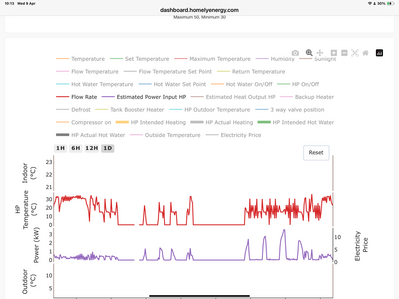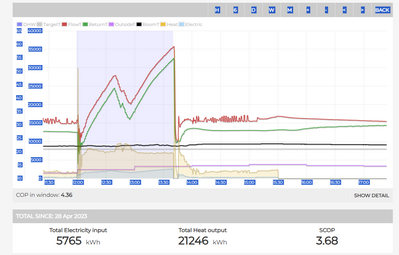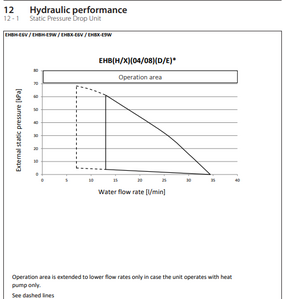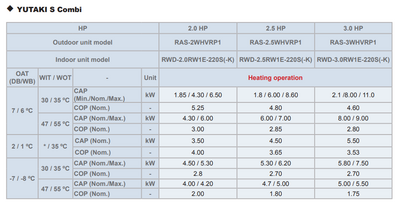Posted by: @jamespaI cant immediately see you are misreading - although I cant be sure, I can only try to deduce, which lines correspond to which scales. Im presuming you are calculating 1.6kW from 7l/min * DT as there doesn't appear to be a scale that reads 1.6 (correction - maybe the blue scale does?)
On the published graphs, you can put your mouse over any part of the graph to read the actual value at any point. This is NOT a calculation. I am merely stating the values as reported by the monitoring system. The value of 1.6kW is my estimated average value over the reasonably horizontal time period. The reported DT and 7 l/min flow values stack up in calculation to give a 1.6kW output so it is not false. I am musing about whether the peak power output has been turned down by reducing the peak flow from 24 l/min bringing it down to a normal 1:3 ratio but I do not know enough about Daikin to validate this. Need to go back somewhat in time on the monitor if poss. to -2C OAT to see what the actual peak output was at the limit. Very interesting though.
Private individual. No affiliation with commercial "Heat Geeks" of same coincidental name.
Posted by: @heatgeekOn the published graphs, you can put your mouse over any part of the graph to read the actual value at any point. This is NOT a calculation. I am merely stating the values as reported by the monitoring system. The value of 1.6kW is my estimated average value over the reasonably horizontal time period.
After I wrote my initial comment I guessed that might be the case!
Posted by: @heatgeekI am musing about whether the peak power output has been turned down by reducing the peak flow from 24 l/min bringing it down to a normal 1:3 ratio but I do not know enough about Daikin to validate this.
Turning down the flow might reduce the peak power output but I cant see how it would reduce the minimum. If you reduce the amount of heat that is transported away, once the compressor reaches its minimum modulation (and thus heat production) level the compressor/water will simply overheat (and thus be forced to cycle). Like a factory, if you stop taking goods away you may be able to reduce the speed of the production line, but once its reached the minimum possible speed you have to shift to part time working otherwise you end up piling up goods on the forecourt.
Its said that all the Daikin models 8kW or less (in any given line) are in fact the same hardware, just software limited. I haven't personally verified this however. If it is true then either the modulation ratio of the lower output models will be less or Daikin do have something which allows an extended modulation ratio. When I was looking I found it difficult to get detailed info on Daikin and their tech support was close to useless, basically the stock answer was 'ask your installer'. However they are certainly well thought of in the aircon business.
Which model exactly is this? Its certainly interesting. An 8kW heat pump that modulates down to 1.6kW is almost a universal retrofit device. Most retrofits are 8kW or less, and you wouldnt want to go much lower than 3-4 because of DHW reheat, so such a heat pump fits a vrery high proportion of properties. if we are to ramp up roll out we need to simplify the design/installation process and a 'universal' heat pump is an important component of this. Maybe thats why Octopus used/use daikin?
4kW peak of solar PV since 2011; EV and a 1930s house which has been partially renovated to improve its efficiency. 7kW Vaillant heat pump.
@jamespa Don’t know whether it helps but, I am attaching a Homely Dashboard plot from the last 24 hours showing flow rate and power input for my Daikin 8 kW ASHP EDLA03 monobloc.
Regards, Toodles.
Toodles, heats his home with cold draughts and cooks food with magnets.
@robs On the 5. 10kW Viessmann Vitocal in Sheffield. What is causing the heat pump to turn off and on every hour (approx). It it a room thermostat or something within the heat pump?
Hitachi Yutaki SCombi Heat Pump
(Indoor Unit ) RWD-3.0RW1E-220S-K
(Outdoor Unit) RAS-3WHVRP1
2024 build bungalow
Southern england
179 m2
High level of insulation
Underfloor heating
All 12 circuits are fully open all the time
1 thermostat in family room
7KW heat pump
50 litre buffer tank (4 port)
3.6KW solar panels
Energy used by heating 2527 KWh - 7527 KWh (SCOP 3.5 approx)
I'm pretty sure Viessmann use an energy integral algorithm like Vaillant, so what we are seeing is that at a near constant outside temperature (4-5C) it is starting the heat pump at a near constant frequency (approximately every hour).
@heatgeek here is the Farnborough Daikin on 7th April. A steady 7+kW when heating hot water and then a steady 1.6kW when it returns to space heating. Its certainly beginning to look kike this may have a wider modulation range than most. Why aren't they shouting about it?
4kW peak of solar PV since 2011; EV and a 1930s house which has been partially renovated to improve its efficiency. 7kW Vaillant heat pump.
@jamespa Firstly, I can confirm that the Daikin heat pump in the example was producing 8kW output during the cold spell in January.
Regarding this topic, there seems to be a prevailing view, especially among Vaillant users, that the minimum output of a heat pump cannot be less than 30% of maximum output. I therefore wish to postulate an alternative view as to why this is not so and where this is emanating from.
Firstly, the following information taken from an Internet article:
“Variable Speed Operation:
Inverter heat pumps use variable-speed compressors, which allow them to adjust their output to match the heating or cooling demand, rather than simply cycling on and off.
Modulation Range:
The compressor's speed, and thus its capacity, can be modulated continuously within a range, typically from a minimum of around 20% (depending on the compressor model) to 100% of full capacity.”
Then there is this from Graham Hendra:
“I also get asked what the minimum output is? Again easy to measure if you know the flow and return temperatures and the flow rate. In all the units I’ve tested its usually between 15 and 20% of the name plate capacity.
Back to my house, remember, it has a 6kW load when its 21 degrees inside and -2 degrees C outside. I have a 10kW unit installed, its minimum output is 900 Watts, see below. At this output the compressor is running at only 1200 rpm. Its maximum is 9000 rpm. Manufacturers very rarely tell you minimum outputs or efficiency data at part load, they don’t have to, It’s not a requirement in the standards so they only quote maximum figures. Why?”
So, with this evidence, where is this 30% myth coming from? IMHO it is emanating from users of fixed flow heat pumps. As there seems to be a supermajority of Vaillant users, this transforms into heat pump gospel. The reason, in my view, is simple. An 8kW heat pump is typically set up with a 24 l/min fixed flow with 5C DT at design temperature. It will modulate with DT down to probably 1.5C DT before cycling as it probably cannot go lower. This is 30% of 5C DT and as flow is fixed, 30% of rated power. As I have tried to explain some posts before, it is the reason why Grant specify that maximum output should be set at 8C, clearly to provide wider range.
Contrast this with Daikin et al. As DT is managed and flow is varied, it can modulate flow of an 8kW HP down to ~7 l/min as per attached Daikin diagram. At 5C DT, this is 2kW. If it furthermore can clamp flow at 7 l/min and allow DT to decrease, then at 7 l/min and 2C DT, power can reduce theoretically to 1kW, similar to Hendra example above. In the Daikin example previously given, flow is 7 l/min with 3.3C DT.
In my view, this explains a few things. Fixed flow heat pumps were designed for use with buffer tanks with variable flow happening on the output side. Buffer tanks can be inefficient so, not unreasonably, a drive was initiated to eliminate them. This had a consequence on fixed flow HP’s as zone control with thermostats cannot be used. As @heacol has pointed out, when valves are closed, the water pump speeds up to maintain fixed flow which is catastrophic as the DT across remaining rads goes to hell. So, voila, open loop working was invented as it is the only practical method of operation to maintain full flow. This philosophy was then imposed on all others as the way to do things.
Take a hypothetical example of a typical 10kW, 29 l/min, 5C DT Daikin heat pump in a reasonably large house with UFH with 16 loops and thermostats in all rooms. As long as the minimum 6 l/min can be guaranteed with some open loops, the rest can be switched on and off at will by stats and the Daikin will modulate flow accordingly and maintain 5C across all loops within its modulation range, providing full flexibility of room temperature CONTROL, as per Part L, irrespective of solar gain, etc, and maximum efficiency. No need for open loop working. There is nothing wrong with the latter as a workaround for fixed flow heat pumps but it is not a panacea for everyone. It may also be why Brendon Uys says that Vaillant users should replace their water pumps with DT-controlled Grundfos Magna 3 ones but he is not explaining himself. It appears that there is the inherent ability for heat pumps to provide wide power range but, as you say, manufacturers either do not shout about it or are too fat, dumb and lazy to implement it or explain it.
In summary, there is no universal answer to heat pump heaven as every case is different.
Private individual. No affiliation with commercial "Heat Geeks" of same coincidental name.
Posted by: @heatgeekRegarding this topic, there seems to be a prevailing view, especially among Vaillant users, that the minimum output of a heat pump cannot be less than 30% of maximum output. I therefore wish to postulate an alternative view as to why this is not so and where this is emanating from.
Posted by: @heatgeekPosted by: @heatgeekSo, with this evidence, where is this 30% myth coming from? IMHO it is emanating from users of fixed flow heat pumps. As there seems to be a supermajority of Vaillant users, this transforms into heat pump gospel.
I cant speak for others but my information is based on examination of the specification tables of the several heat pump manufacturers which publish minimum as well as maximum output. As I have said previously not all do (or at least I've not been able to find it for some manufacturers, including Samsung and Daikin). I looked a couple of years ago at the performance tables for 12 manufacturers (to the extent that I could find them) and none had a modulation range (by which I mean the ratio of max output at -2C/45C flow temperature to min output at 12C/35C flor temperature) in excess of a factor of 3 and some were less. Obviously I could only do this for the manufacturers that gave minimum outputs, and not all 12 did. Before you ask I cant remember how many, but it was obviously enough to form a view good enough to help with elimination, based on the only evidence available at the time)
Modulation Range:
The compressor's speed, and thus its capacity, can be modulated continuously within a range, typically from a minimum of around 20% (depending on the compressor model) to 100% of full capacity.”
'and thus its capacity' assumes that output is a linear function of modulation frequency. But I dont think thats the key point so lets not argue over this one. However one point worth noting is that the comparison of interest is max output at high FT/low OAT with min output at lowFT/High OAT (exact values dependent on installation of course). This is, from the datasheets I have seen, not as good as the ratio at any single FT/OAT combination
Posted by: @heatgeekAn 8kW heat pump is typically set up with a 24 l/min fixed flow with 5C DT at design temperature. It will modulate with DT down to probably 1.5C DT before cycling as it probably cannot go lower. This is 30% of 5C DT and as flow is fixed, 30% of rated power. As I have tried to explain some posts before, it is the reason why Grant specify that maximum output should be set at 8C, clearly to provide wider range.
Contrast this with Daikin et al. As DT is managed and flow is varied, it can modulate flow of an 8kW HP down to ~7 l/min as per attached Daikin diagram. At 5C DT, this is 2kW. If it furthermore can clamp flow at 7 l/min and allow DT to decrease, then at 7 l/min and 2C DT, power can reduce theoretically to 1kW, similar to Hendra example above. In the Daikin example previously given, flow is 7 l/min with 3.3C DT
If it is correct that heat pump manufacturers deliberately clobber their compressor capabilities by working it (when demand is low) at a flow speed that is to high, then there is an easy test, namely to reduce the water pump speed. It seems unlikely they would do this, but then it also seems unlikely that Vaillant charge £500 for a 4K resistor (yet they do)!
Posted by: @heatgeekSo, voila, open loop working was invented as it is the only practical method of operation to maintain full flow.
Definitely not (not least because it predates heat pumps). The consistent rationale for open loop working is that it means, at least in theory, you are operating at lowest possible flow temperature (because you have the maximum possible emitter area) which is generally the way to maximise COP. I have never it argued (and neither would I argue) that the principal reason for open loop working is to maintain flow rate. If all you were trying to do was that, you would simply fit a bypass valve, which some do.
Posted by: @heatgeekTake a hypothetical example of a typical 10kW, 29 l/min, 5C DT Daikin heat pump in a reasonably large house with UFH with 16 loops and thermostats in all rooms. As long as the minimum 6 l/min can be guaranteed with some open loops, the rest can be switched on and off at will by stats and the Daikin will modulate flow accordingly and maintain 5C across all loops within its modulation range, providing full flexibility of room temperature CONTROL, as per Part L, irrespective of solar gain, etc, and maximum efficiency.
Controls do not necessarily equate to efficiency (or even control, for that matter). As I say above the principal reason for open loop working is to deliver the energy the house needs (which is determined by the outside conditions and the desired temperature) through the highest possible emitter area and thus at the lowest possible flow temperature and thus the highest efficiency.
Posted by: @heatgeekIt appears that there is the inherent ability for heat pumps to provide wide power range but, as you say, manufacturers either do not shout about it or are too fat, dumb and lazy to implement it or explain it.
We can't reach that conclusion yet. We need to dissect out the compressor capability to see whether issues to do with flow rate are in fact clobbering the modulation capabilities. If they are then its a bit of a condemnation of the manufacturers that do this. Or it may just be that Daikin make their own unique compressors but choose not to shout about them.
I think elements of your central argument are rather confected and the driving argument for open loop working does not (and never has) depended on flow rate considerations (which doesn't mean that they aren't invoked once the decision to operate open loop has been mad since, once that decision has been made, there is no need to deal with flow rate issues).
Nevertheless the Farnborough Daikin appears to operate at 8kW/low OAT and 1.6kW/high OAT which seems to suggest that better compressors are available than some use. I don't know if Daikin make their own compressors so have access to unique technology. Im going to look at it a bit more closely, its a pity Daikin do not publish detailed tables of performance.
PS here is an extract from the specification table for the Daikin High temperature monoblock, displaying the (until now assumed typical) 3:1 modulation range. The datasheet I have for the R32 monobloc, of which the Farnborough one is an example doesn't specify the minimum output.
the water pump is a PWM pump, although it might be inferred that it is operated at fixed speed 9cant be sure about this). Curious dont you think, particularly since this is a later model.
4kW peak of solar PV since 2011; EV and a 1930s house which has been partially renovated to improve its efficiency. 7kW Vaillant heat pump.
Further to the above I discovered a bit more/had an additional thought about Daikin compressors. Firstly Daikin do make their own compressors so its quite plausible that they do have superior technology.
However it also occurs to me that compressor modulation limits are 'soft', ie a design choice/trade off not a fixed number. I imagine that, at the high rate end, wear and tear and noise limit how fast you can drive it. Those are clearly both soft limits, particularly if the design assumption is that the high end is rarely used (you can run car engines at 4k RPM, but you wouldn't do so for long!). At the low end I believe its loss of efficiency due to refrigerant leaking past the seal, but again this is a soft limit. Perhaps Daikin pushed both for the Atherma 3M, maybe so that they could get away with a single model covering 4-8kW. Its interesting that the Altherma3 HT appears, based on the spec reproduced above, to revert to 3:1.
This is an interesting area which deserves more investigation, not least because we dont really understand how significant any penalty due to cycling is. Prior to inverter driven compressors the concern was wear and tear due to the start up load. Inverter driven compressors (with the possibility of controlled slow start up) seem to have mitigated that, at least in terms of what the industry says, but there is still a thermal penalty of unknown magnitude. Some people get really concerned about cycling and its significance materially affects the (still controversial) decision on whether to over-size or right-size a heat pump. Solid data on this would be most illuminating. I suspect analysis of the average COP registered on heatpumpmonitor during cycling, vs puplished cops or cops at similar conditions where cycling was not occurring (ie a better matched heat pump) may yield some, but I have other things to do!
4kW peak of solar PV since 2011; EV and a 1930s house which has been partially renovated to improve its efficiency. 7kW Vaillant heat pump.
@jamespa There is a lot here but I wish to deal with the fundamentals first.
Firstly, you have ignored the statement by Graham Hendra that he has TESTED several heat pumps and that they all exhibit low power limits of 15-20% of rated power, in line with the other statement I quoted from an education brief online. GH is a respected designer in the industry. Are we saying that he doesn’t know what he is talking about?
I need to contest something else.
Posted by: @jamespaIf it is correct that heat pump manufacturers deliberately clobber their compressor capabilities by working it (when demand is low) at a flow speed that is too high, then there is an easy test, namely to reduce the water pump speed.
I do not understand this statement. How is a compressor being clobbered by high water flow rate? We are talking about the high end of the OAT spectrum with low temperature water flow. On the enthalpy diagram, the horizontal subcool/superheat lines are at their closest with the compressor toodling along at low speed, the line (temperature) separation determined only by the minimum power level of the compressor. The compressor only expects that the POWER it generates is carried away from the PHE by the combination of water flow and DT. This could be high flow/low DT or low flow/DT within certain limits.
The compressor has a target water output temperature set by parameter or WC and it observes the incoming water temperature and raises it to the required output temperature. It also has a minimum temperature resolution (DT) which, by practical observation, is probably 1.5C. Daikin/Samsung also specify lowest flow limit of 7 l/min which is probably a water pump issue (don't know what). So, the variability of water flow/DT determines how varying heat power is carried away and within which limits.
In the case of a fixed flow HP (e.g. Vaillant), this range is 5C to 1.5C (30% of peak). In the case of Grant, this could be 8C to 1.6C (20%), which aligns with GH statement. In the case of a DT-controlled HP (Daikin/Samsung), this is more nuanced as both flow and DT can alter. The HP can slow the flow to widen DT for better resolution. So, for an 8kW Daikin with 7 l/min limit and 20% power limit, low power output would be 1.6kW and 3.3C, exactly what we are observing. If the compressor was capable of following down to 1.5C DT, the power limit would be even lower than 20%.
Therefore, fast water flow does not clobber the compressor and is misleading. The fundamental question here is whether the Daikin compressor is unique or whether GH is correct that most heat pumps are capable of this. As we are at the tail end of the heating season and you have a Vaillant heat pump, why don’t you experiment and lower your flow speed to observe what your low power output really is and the effect on cycling? This would be very informative. Unfortunately I do not have a fixed flow option.
Private individual. No affiliation with commercial "Heat Geeks" of same coincidental name.
Posted by: @heatgeekFirstly, you have ignored the statement by Graham Hendra that he has TESTED several heat pumps and that they all exhibit low power limits of 15-20% of rated power, in line with the other statement I quoted from an education brief online. GH is a respected designer in the industry. Are we saying that he doesn’t know what he is talking about?
Thank you for pointing that out, I should have commented on this also (but as you say there is a lot here). I did note this comment, am not disputing either it or Grahams competence, and it is broadly consistent with the manufacturer data I have examined.
However it didn't seem directly to address the interesting question (in the context of cycling) which is the ratio between the minimum output at high OAT/low FT and the max output at low OAT/higher FT. I therefore think the comment needs clarifying before we can factor it into our discussion.
Posted by: @heatgeek
If it is correct that heat pump manufacturers deliberately clobber their compressor capabilities by working it (when demand is low) at a flow speed that is too high, then there is an easy test, namely to reduce the water pump speed.
I do not understand this statement. How is a compressor being clobbered by high water flow rate? We are talking about the high end of the OAT spectrum with low temperature water flow. On the enthalpy diagram, the horizontal subcool/superheat lines are at their closest with the compressor toodling along at low speed, the line (temperature) separation determined only by the minimum power level of the compressor. The compressor only expects that the POWER it generates is carried away from the PHE by the combination of water flow and DT. This could be high flow/low DT or low flow/DT within certain limits.
I do not understand this statement. How is a compressor being clobbered by high water flow rate? We are talking about the high end of the OAT spectrum with low temperature water flow.
OK I used loose words for brevity.
What I mean is that if, as I think you are suggesting, the (wider than a factor of 3*) modulation characteristics of the compressor are being masked/frustrated by some manufacturers by enforcing a higher than necessary water flow rate (at high OAT) or indeed a lower than desirable flow rate (at low OAT), and thus a dT outside a range required for control purposes/the workings of the compressor at when the heat demand is low then {they are effectively allowing the rather easily controllable flow rate to compromise the performance of the unit.
Is that clearer?
Posted by: @heatgeekThe fundamental question here is whether the Daikin compressor is unique or whether GH is correct that most heat pumps are capable of this.
I agree with the first part of the sentence but see above for my qualification of the second part. As I point out above compressor modulation range is to some extent a design choice, so it may alternatively be that many compressors are capable of the wider modulation range but the designers choose not to access it for reasons we don't yet know.
The second fundamental question is, to what extent does cycling actually matter with inverter driven compressors and how does that trade off with any compromises made in order to extend either compressor modulation range or design for fixed DT. Its interesting in this context that Daikin specify only a factor of 3 between min and max in their slightly later HT model. Im very tempted to start another thread entitled 'How much does cycling actually matter?'. We speak a lot about it and some people go to extraordinary lengths to design it our but have absolutely zero evidence SOFAIK. The abhorrence of it dates back to fixed speed compressors so may or may not be outdated.
* when comparing performance at low OAT/higher FT with high OAT/lower FT
4kW peak of solar PV since 2011; EV and a 1930s house which has been partially renovated to improve its efficiency. 7kW Vaillant heat pump.
@jamespa Quick one for your information. Specs for Hitachi 3HP heat pump which one member of this forum has. Note min/max power. Ratio 2.1/11 = 19%.
Private individual. No affiliation with commercial "Heat Geeks" of same coincidental name.
- 26 Forums
- 2,342 Topics
- 53 K Posts
- 288 Online
- 6,000 Members
Join Us!
Worth Watching
Latest Posts
-

RE: Are We Sleepwalking Into Another Race to the Bottom?
…otherwise known as “hive got news for you”. And don’...
By Majordennisbloodnok , 40 minutes ago
-
RE: Configuring third party dongle for Ecodan local control
Logically, I'll fall into that category so the natural ...
By Sheriff Fatman , 1 hour ago
-

RE: Controlling Daikin Altherma via P1P2 and Home Assistant
I haven’t got a Daikin but I have been having some fun ...
By Majordennisbloodnok , 2 hours ago
-
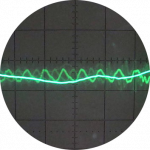
RE: Setback savings - fact or fiction?
@robs — thanks again for your detailed comments. Some r...
By cathodeRay , 4 hours ago
-
RE: Free Ecoheat Heat Pump Install
I don't mind thread drift, it's how conversation natura...
By Deltona , 5 hours ago
-

RE: A Smarter Smart Controller from Homely?
@papahuhu I hope you get a swift resolution. Regards, T...
By Toodles , 8 hours ago
-

RE: Poll for Time of Use, tariffs, technology
That’s fine by me too Major, I feel it is a sad reflect...
By Toodles , 9 hours ago
-

Bingo. Sometimes a judiciously placed size 10 bovver bo...
By Majordennisbloodnok , 9 hours ago
-
RE: Mitsubishi Ecodan 11.2kW heat pump with low COP
@ciocoiu-alexandru I can't provide the same level of di...
By Sheriff Fatman , 10 hours ago
-
RE: Octopus Cosy Heat Pump Owners & Discussion Thread
Recently had my follow up with octopus for the vibratio...
By swwils , 11 hours ago
-

The three technical issues I'm considering are: BMS...
By Transparent , 12 hours ago
-
RE: LiFePO4 lithium battery fires and explosions
@transparent Your post may fit better in th...
By Batpred , 12 hours ago
-

RE: British Gas vs Octopus Energy vs Heat Geek vs EDF vs Aira vs OVO vs EON.Next vs Boxt
@jamespawhite, if you could be bothered, you could also...
By Mars , 14 hours ago
-
RE: Commencing on an ASHP Installation Process
I've got a bit of time to draft something today, so the...
By Sheriff Fatman , 1 day ago
-
RE: Help with heat pump sizing
@amin I dont think materially relative to t...
By JamesPa , 1 day ago
-

@majordennisbloodnok I have decided to take the plunge....
By TechnoGeek , 1 day ago
-
RE: Different dT on each radiator?
I cant sorry. Its based on some calculations I did fro...
By JamesPa , 2 days ago
-
RE: Help me keep the faith with my air source heat pump installation
@simonf thats interesting as I’ve noticed my flow and r...
By AdamK , 2 days ago

